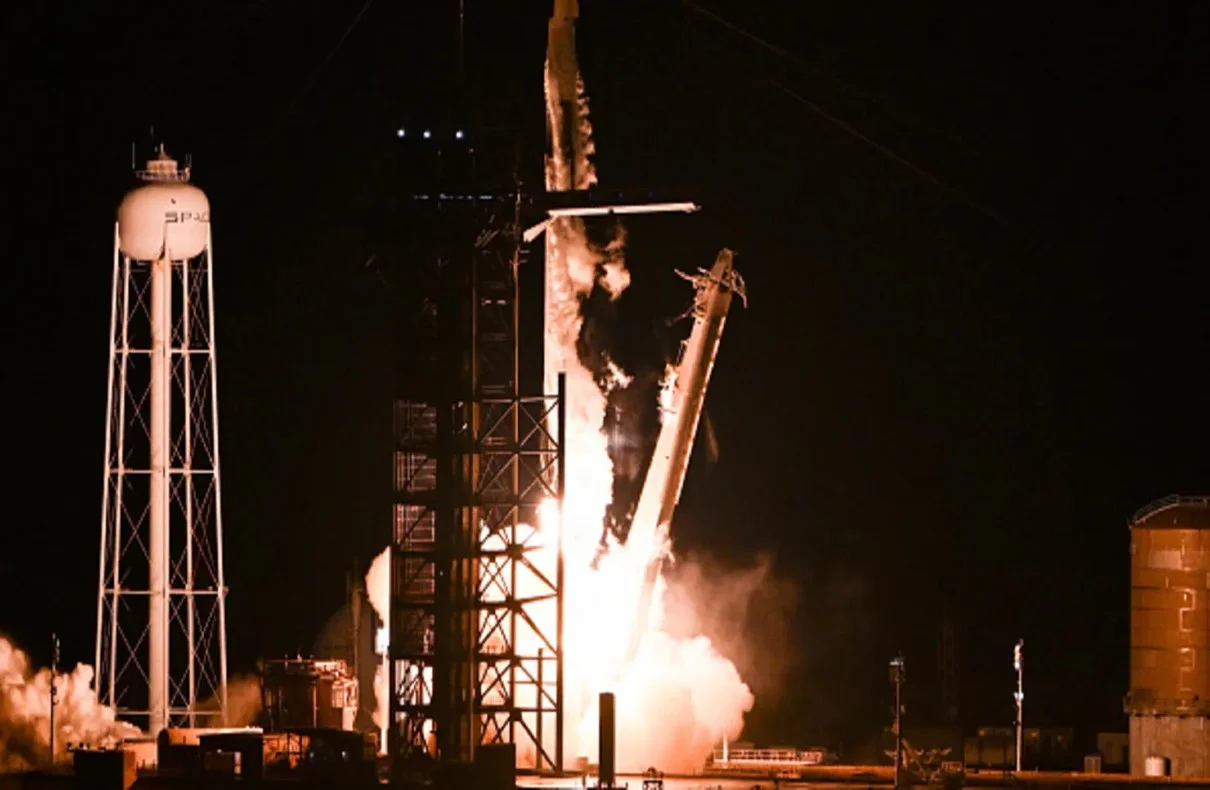SpaceX’s most recent mission, a daring and perilous journey into Earth’s Van Allen radiation belts, has just taken off with a crew of four people who will also attempt the first commercial spacewalk.
The Polaris Dawn mission was launched from NASA’s Kennedy Space Center in Florida on Tuesday at 5:23 a.m. Eastern Standard Time.
Several weather delays in late August and on Tuesday morning delayed the Polaris Dawn crew’s attempts to lift off, ultimately leading to the launch.
As the countdown clock reached zero, SpaceX’s Falcon 9 rocket at NASA’s Kennedy Space Center in Florida burst into a blinding fire and thunderous explosion.
The crew aboard the rocket held the rocket strapped inside an igloo-shaped SpaceX Crew Dragon capsule at a height of about 13 feet (4 meters) at its base while the rocket moved away from the clutches of Earth’s gravity.
The mission, called Polaris Dawn, was scheduled to lift off at 3:38 a.m. Eastern time on Tuesday. Because of bad weather at the launch pad, SpaceX has decided not to launch at its first opportunity Tuesday morning, but will try again at the second scheduled time. The new launch time is 5:23 a.m. Eastern time.
“Due to adverse weather conditions at the launch site, we are now targeting 5:23 a.m. ET for Falcon 9 to launch the @PolarisProgram Polaris Dawn mission to orbit,” SpaceX posted on X.
At the time of the time change, no propellant had yet been loaded into the rocket. It was previously reported that if the weather was not favorable for the 5:23 a.m. launch, there would be another opportunity at 7:09 a.m. Eastern Time.
SpaceX livestreamed the event on X, the social media platform formerly known as Twitter that SpaceX CEO Elon Musk acquired in 2022.
This launch attempt comes after a series of problems hampered the launch of the Polaris Dawn crew in late August. First, the planned date was delayed by 24 hours because of problems with ground equipment at the launch site, and then SpaceX had to cancel two more attempts because of weather forecasts.
Around the same time, the Falcon 9 — the type of rocket that carried Polaris Dawn into space — malfunctioned during a routine satellite mission, causing federal regulators to briefly ground all Falcon 9 rockets. SpaceX received permission to fly the Falcon 9 again on Aug. 30.
To further complicate launch prospects, SpaceX not only needs clear weather to fly the mission, but also must ensure that waters and winds are calm when the crew returns from space after their five-day excursion. The timing of their return could be critical. Because a spacewalk would deplete oxygen reserves, the Polaris Dawn mission would only have enough life support for five or six days in space.
The first stage of the Falcon 9 rocket, which is located below the aircraft, will have used up most of its fuel about two and a half minutes after takeoff. By that time, the upper stage of the rocket will have fired up and was continuing to drive the Crew Dragon spacecraft at a high rate of speed, while the first stage of the rocket will have separated from the second stage.
The first stage of the Falcon 9 will be guided back to Earth to land on a marine platform where it will be repaired and reused for other missions. It’s a significant step that SpaceX claims lowers the price of rocket launches.
To enter Earth orbit, the Falcon 9 rocket needs to reach “orbital velocity,” which is greater than 17,000 mph. Once it reaches the desired speed, the Crew Dragon spacecraft will split out and spend the remainder of the journey navigating the vacuum of space using just its onboard propulsion.
Polaris Dawn was the result of a partnership between SpaceX and the banking business Shift4 Payments, which was created by millionaire Jared Isaacman. The company’s first space flight was the Inspiration4 mission, which launched in September 2021.
However, this flight is by no means easy. Isaacman and his team are expecting to break many records during the mission, together with SpaceX engineers Anna Menon and Sarah Gillis, as well as close friend and former U.S. Air Force pilot Scott “Kidd” Poteat.
At first, the crew of SpaceX’s capsule wants to break the record altitude for Earth orbit, which was set in 1966 by NASA’s Gemini 11 mission at 1,373 kilometers (840 miles). That record will be broken by roughly twenty miles, or thirty-two kilometers, if Polaris Dawn is successful.
Since NASA’s Apollo program, which ended in 1972 and had 24 people traveling 25,000 miles to the moon instead of remaining in Earth orbit, the Polaris Dawn mission will also be the highest human flight. Perhaps the longest space mission a female pilot has ever gone on is Polaris Dawn.
The civilian crew will undertake a historic spacewalk on the third day of the mission, orbiting the planet at a lower altitude of roughly 700 kilometers above it.
This attempt would be dangerous, as it would expose the four crew members and the interior of the Crew Dragon to the vacuum of space. The pressure difference in this situation could make it difficult to close the vehicle’s hatch. In addition, exposure to vacuum could cause toxic substances to be released from equipment when the cabin is re-pressurized, although SpaceX says it has taken steps to prevent this.

